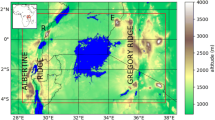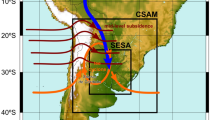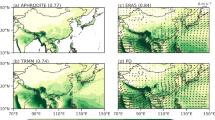Abstract
Many recent studies have reported the presence of two types of El Niño events in observation: Cold Tongue (CT) El Niño and Warm Pool (WP) El Niño. We investigate the sensitivity of a model simulating two types of El Niño by changing a convective triggering parameter (Tokioka parameter). When deep convections are highly suppressed with a large Tokioka parameter, the model is capable of simulating distinct two-types of El Niño. However, the model has a problem in simulating two-types of El Niño distinctively when the Tokioka parameter is small, because the location of the maximum precipitation anomaly related to the CT El Niño is significantly shifted westward, leading to an atmospheric response pattern similar to that of the WP El Niño. Our results suggest that the mean precipitation over the eastern equatorial Pacific and the resultant zonal distribution in atmospheric feedback associated with ENSO can be one of the crucial factors for simulating two-types of El Niño.
Similar content being viewed by others
References
Ashok, K., S. K. Behera, S. A. Rao, H. Weng, and T. Yamagata, 2007: El Niño Modoki and its possible teleconnection. J. Geophys. Res., 112, C11007, doi:10.1029/2006JC003798.
Delworth, T. L., and Coauthors, 2006: GFDL’s CM2 global coupled climate models. Part I: Formulation and simulation characteristics. J. Climate, 19, 634–674.
Guilyardi, E., and Coauthors, 2004: Representing El Niño in coupled ocean-atmosphere GCMs: the dominant role of the atmospheric component. J. Climate, 17, 4623–4629.
____, P. Braconnot, F.-F. Jin, S. T. Kim, M. Kolasinski, T. Li, and I. Musat, 2009: Atmosphere feedbacks during ENSO in a coupled GCM with a modified atmospheric convection scheme. J. Climate, 22, 5698–5718.
Ham, Y.-G. and J.-S. Kug, 2012: How well do current climate models simulate two-types of El Niño?. Climate Dyn., 39, 383–398, doi:10.1007/s00382-011-1157-3.
Kang, I.-S. and J.-S. Kug, 2002: El Niño and La Niña SST Anomalies: Asymmetric Characteristics Associated with Their Wind Stress Anomalies. J. Geophy. Res., 107(D19), 4372, doi10.1029/2001JD000393.
Kao, H.-Y. and J.-Y. Yu, 2009: Contrasting eastern-Pacific and central- Pacific types of ENSO. J. Climate, 22, 615–632.
Kim, D., J.-S. Kug, I.-S. Kang, F.-F. Jin, and A. Wittenberg, 2008: Tropical Pacific impacts of convective momentum transport in the SNU coupled GCM. Climate Dyn., 31, 213–226.
____, Y.-S. Jang, D.-H. Kim, Y.-H. Kim, M. Watanabe, F.-F. Jin and J.- S. Kug, 2011: ENSO sensitivity to cumulus entrainment in a coupled GCM. J. Geophys. Res., 116, D22112, doi:10.1029/2011JD016526.
Kug, J.-S., F.-F. Jin, and S.-I. An, 2009: Two types of El Niño events: Cold tongue El Niño and warm pool El Niño. J. Climate, 22, 1499–1515, doi:10.1175/2008JCLI2624.1.
____, M.-S. Ahn, M.-K. Sung, S.-W. Yeh, H.-S. Min, and Y.-H. Kim, 2010a: Statistical Relationship between Two Types of El Niño Events and Climate Variation over the Korean Peninsula. Asia-Pacific J. Atmos. Sci., 46, 467–474.
____, J. Choi, S.-I. An, F.-F. Jin, and A. T. Wittenberg, 2010b: Warm Pool and Cold Tongue El Niño events as simulated by the GFDL 2.1 coupled GCM. J. Climate, 23, 1226–1239.
____, and Y.-G. Ham, 2011: Are there two types of La Nina events?. Geophy. Res. Lett., 38, L16704, doi:10.1029/2011GL048237.
Lee, T. and M. J. McPhaden, 2010: Increasing intensity of El Niño in the central equatorial Pacific. Geophys. Res. Lett., 37, L14603, doi:10.1029/2010GL044007.
Neale, R. B., J. H. Richter, and M. Jochum, 2008: The impact of convection on ENSO: From a delayed oscillator to a series of events. J. Climate, 21, 5904–5924.
Ren, H.-L. and F.-F. Jin, 2011: Niño indices for two types of ENSO. Geophys. Res. Lett., 38, L04704, doi:10.1029/2010GL046031.
Schneider, E. K., 2002: Understanding differences between the equatorial Pacific as simulated by two coupled GCMs. J. Climate, 15, 449–469.
Smith, T. M., and R. W. Reynolds, 2004: Improved extended reconstruction of SST (1854-1997). J. Climate, 18, 2466–2477.
Tokioka, T., K. Yamazaki, A. Kitoh, and T. Ose, 1988: The equatorial 30–60 day oscillation and the Arakawa-Schubert penetrative cumulus parameterization. J. Meteor. Soc. Japan, 66, 883–901.
Watanabe, M., M. Chikira, Y. Imada, and M. Kimoto, 2011: Convective control of ENSO simulated in MIROC5. J. Climate, 24, 543–562.
Yeh, S.-W., J.-S. Kug, B. Dewitte, M.-H. Kwon, B. P. Kirtman, and F.-F. Jin, 2009: El Niño in a changing climate. Nature, 461, 511–514, doi:10.1038/nature08316.
Yu, J.-Y. and S. T. Kim, 2010: Identification of Central-Pacific and Eastern-Pacific types of ENSO in CMIP3 models. Geophys. Res. Lett., 37, L15705, doi:10.1029/2010GL044082.
Author information
Authors and Affiliations
Corresponding author
Rights and permissions
About this article
Cite this article
Jang, YS., Kim, D., Kim, YH. et al. Simulation of two types of El Niño from different convective parameters. Asia-Pacific J Atmos Sci 49, 193–199 (2013). https://doi.org/10.1007/s13143-013-0020-3
Received:
Revised:
Accepted:
Published:
Issue Date:
DOI: https://doi.org/10.1007/s13143-013-0020-3




